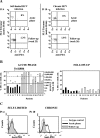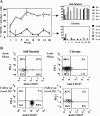PD-1 expression in acute hepatitis C virus (HCV) infection is associated with HCV-specific CD8 exhaustion
- PMID: 16956940
- PMCID: PMC1642188
- DOI: 10.1128/JVI.01177-06
PD-1 expression in acute hepatitis C virus (HCV) infection is associated with HCV-specific CD8 exhaustion
Abstract
Hepatitis C virus (HCV)-specific CD8 cell exhaustion may represent a mechanism of HCV persistence. The inhibitory receptor PD-1 has been reported to be up-regulated in exhausted CD8 cells. Therefore, we studied PD-1 expression longitudinally during acute HCV infection. Most HCV-specific CD8 cells expressed PD-1 at the time of acute illness, irrespective of the final outcome. PD-1 expression declined with the acquisition of a memory phenotype and recovery of an efficient CD8 cell function in resolving HCV infections, whereas high levels were maintained when HCV persisted and HCV-specific CD8 cells remained dysfunctional. Blocking PD-1/PDL-1 interaction with an anti-PDL-1 antibody improved the capacity of expansion of virus-specific CD8 cells.
Figures




 ) indicate HCV NS3 1073 tetramer-positive CD8 cells stimulated with the specific peptide in the presence of a control isotype antibody.
) indicate HCV NS3 1073 tetramer-positive CD8 cells stimulated with the specific peptide in the presence of a control isotype antibody.References
-
- Barber, D. L., E. J. Wherry, D. Masopust, B. Zhu, J. P. Allison, A. H. Sharpe, G. J. Freeman, and R. Ahmed. 2006. Restoring function in exhausted CD8 T cells during chronic viral infection. Nature 439:682-687. - PubMed
-
- Boettler, T., E. Panther, B. Bengsch, N. Nazarova, H. C. Spangenberg, H. E. Blum, and R. Thimme. 2006. Expression of the interleukin-7 receptor alpha chain (CD127) on virus-specific CD8+ T cells identifies functionally and phenotypically defined memory T cells during acute resolving hepatitis B virus infection. J. Virol. 80:3532-3540. - PMC - PubMed
-
- Brown, J. A., D. M. Dorfman, F. R. Ma, E. L. Sullivan, O. Munoz, C. R. Wood, E. A. Greenfield, and G. J. Freeman. 2003. Blockade of programmed death-1 ligands on dendritic cells enhances T cell activation and cytokine production. J. Immunol. 170:1257-1266. - PubMed
-
- Cai, G., A. Karni, E. M. Oliveira, H. L. Weiner, D. A. Hafler, and G. J. Freeman. 2004. PD-1 ligands, negative regulators for activation of naive, memory, and recently activated human CD4+ T cells. Cell Immunol. 230:89-98. - PubMed
-
- Fuller, M. J., D. A. Hildeman, S. Sabbaj, D. E. Gaddis, T. E. Tebo, L. Shang, P. A. Goepfert, and A. J. Zajac. 2005. Cutting edge: emergence of CD127high functionally competent memory T cells is compromised by high viral loads and inadequate T cell help. J. Immunol. 174:5926-5930. - PubMed
Publication types
MeSH terms
Substances
LinkOut - more resources
Full Text Sources
Other Literature Sources
Medical
Molecular Biology Databases
Research Materials

